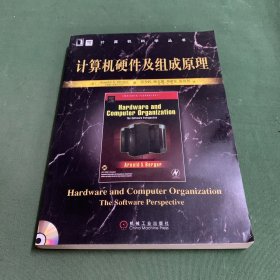
计算机硬件及组成原理
实拍图,高温消毒后发出,下午四点之前的订单一般当天发货 9787111174721
¥ 44.99 7.6折 ¥ 59 九品
仅1件
天津宝坻
认证卖家担保交易快速发货售后保障
作者伯杰
出版社机械工业出版社
出版时间2006-01
版次1
装帧平装
货号9787111174721
上书时间2024-11-28
- 在售商品 暂无
- 平均发货时间 9小时
- 好评率 暂无
- 最新上架
商品详情
- 品相描述:九品
图书标准信息
- 作者 伯杰
- 出版社 机械工业出版社
- 出版时间 2006-01
- 版次 1
- ISBN 9787111174721
- 定价 59.00元
- 装帧 平装
- 开本 其他
- 纸张 胶版纸
- 【内容简介】
-
本书从实用角度详细介绍了现代微处理器的体系结构,旨在为读者揭开现代嵌入式计算机系统PC机的神秘面纱,帮助读者了解这些日常生活中已经无处不在的复杂机器。书中解释了硬件和软件是如协同作用完成现实世界中的各项任务的。
与其他类似的主题简单演示如何设计计算机硬件的图书不同,本书从软件开发者的角度出发,全面分析了整个计算机,重点讲解了计算机的优势和弱点,解释了如何处理存储器问题,如何写出能直接与底层硬件交互并充分利用底层硬件的高效汇编代码。
此外,本书还介绍了从简单的嵌入式应用的8位微处理器转向PC和工作站工作时应如何进行决策。这在同类书中是绝无仅有的。同时,书中还阐明了代码行为和机器操作之间的联系,以帮助读者更好地理解计算机在速度和资源方面的局限性。
本书第1部分:硬件基础和数字体设计
涵盖了计算机和硬件基础,包括逻辑门和简单的数字化设计。详细讲解了现代操作下硬件开发的各种元素,如指令系统体系结构、存储器和I/O结构以及数字转换。
第2部分:汇编语言编程
从最低层——汇编语言,即计算机的指令系统体系结构(ISA)语言——讨论软件;覆盖了当前最常见的三种体系结构,可帮助读者深入理解现代计算机设计的基础。
第3部分:计算机体系结构
从宏观角度剖析计算机,着重探讨了在各自的汇编语言指令系统和编译器环境下,CISC(复杂指令系统计算机)和RISC(精简指令系统计算机)两种微处理器体系结构之间的区别。重点讨论了性能问题,包括统译器优化、操作系统调优、管道、缓存、虚拟内存以及硬件以后的可重配置性等。
本书特点
·采用目前最常见的三种计算机体系结构作为示例:Freescale 6800、Inteli86和ARMv3。
·内容讲解非常直观——书中包含多种简图和图表。
·汇聚作者在业界多年的实际经验和敏锐的洞察力。
本书附带光盘包括:
·业界多位知名专家关于硬件设计和开发的11个视频讲座。
·课件使用的幻灯片。
·三种示例体系结构的指令系统仿真器。 - 【作者简介】
- Arnold S.Berger Washington-Bothell大学计算机和软件系统系的高级讲师,拥有康奈尔大学的学士和博士学位。Berger博士曾但任Arnold Microsystems公司研发部门主管、Advanced Micro Devices公司嵌入式工具的营销经理和惠普公司的研发项目经理。Berger博士已发表了40多篇关
- 【目录】
-
Prdface
Acknowledgments
What's on the DVD-ROM?
CHAPTER 1:Introduction and Overview of Harware Architecture
Introduction
A Brief History of Computing
Number Systems
Convertin Decimals to Bases
Engineering Decimals to Bases
Engineerinng Notation
Summary of Chapter1
Exercises for Chapter1
CHAPTER 2:Introduction to Digital Logic
Electronic Gate Desription
Truth Tables
Summary of Chapter2
Exercises for Chapter2
CHAPTER 3:Introdrction to Asynchronous Logic
Introduction
Laws of Boolean Algebra
The Karnaugh Map
Clocks and Pulses
Summary of Chapter3
Exercises for Chapter3
CHAPTER 4:Introduction to Synchronous Logic
Flip-Flops
Storage Ragister
Summary of Chapter4
Exercises for Chapter4
CHAPTER 5:Introduction to State Machines
Modern Hardware Design Methodollgies
Summary of Chapter5
Exercises for Chapter5
CHAPTER 6:Bus Organization and Memory Design
Bus Organixation
Address Space
Direct Memory Access(DMA)
Summary of Chapter6
Exercises for Chapter6
CHAPTER 7:Memory Organization and Assembly Language Programming
Introduction
Label
Effective Addresses
Pserdo Opcodes
Data Storage Directives
Analysis of an Assembly Language Program
Summary of Chapter7
Exercises for Chapter7
CHAPTER 8:Programming in Assembly Language
Introduction
Assembly Language and C++
Stacks and Subroutines
Summary of Chapter8
Exercises for Chapter8
CHAPTER 9:Advanced Assembly Language Programming Concepts
Introduction
Advanced Addressing Modes
68000Instructions
MOVE Intructions
Logical Intructions
Other Logical Instructions
Summary of the 68K Instructions
Compilers and Assemblers
Summary of Chapter9
Exercises for Chapter9
CHAPTER 10:The Intel x86 Architecture
Introduction
The Architecture of the 8086CPU
Data,Indes and Pointer Registers
Flag Registers
Segment Registers
Instrrction Pointer(IP)
Memory Addressing Modes
X86 Instrrction Format
……
CHAPTER 11:The ARM Architecture
CHAPTER 12:Interfacing with the Real World
CHAPTER 13:Intoduction to Modern Computer Architectures
CHAPTER 14:Memory Revisited,Caches and Virtual Memory
CHAPTER 15:Performance Issues in Computer Architecture
CHAPTER 16:Future Trends and Reconfigurable Hardware
CHAPTER A:Solutions for Odd-Numbered Exercises
About the Author
Indes
点击展开
点击收起
相关推荐
— 没有更多了 —





















以下为对购买帮助不大的评价